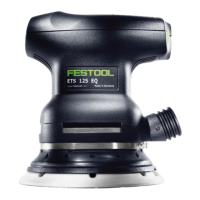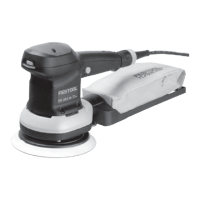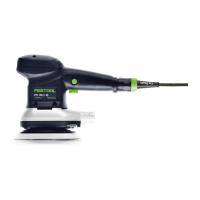16
ETSC 125 Li
GB
Constant speed
The preselected motor speed is kept constant
through electronic control. This means that, if the
machine is used as intended (reasonable contact
pressure), a constant sanding speed is achieved.
Setting and adjusting the speed
The speed can be set
[1-5]
between 6000 and
10000 min
-1
using the adjusting wheel.
For sanding, we recommend the following settings
for the adjusting wheel
[1-5]
:
7.2 Replacing the sanding pad [4a]
An optimal work result can only be achieved
using original accessories and consumables.
The use of non-original accessories or con-
sumables invalidates the right to claim under war-
ranty.
Warning!
Do not perform any structural
changes in the open interior space of the ma-
chine when the sanding pad is dismantled.
Undo the four screws.
Remove the sanding pad by pulling it down-
wards.
Attach the new sanding pad.
Use four screws to tighten it by hand (2.5 Nm).
Hardness of the sanding pad
Adapted to the surface being processed, the ma-
chine can be equipped with sanding pads of differ-
ent hardnesses.
Soft:
Universal for coarse and fine sanding, for flat
and convex surfaces.
Extra-soft:
Fine sanding of moulded parts, arches,
radii. Do not use on edges.
7.3 Attaching sanding accessories using
StickFix [4b]
The suitable StickFix sandpaper and StickFix sand-
ing cloth can be attached quickly and simply to the
StickFix sanding pad.
Affix the self-adhesive sanding accessory to the
sanding pad.
In the case of a weakening adhesive effect of
the StickFix surface, the sanding pad acces-
sories, in particular those which are not yet touch-
ing the workpiece,
may come loose from the sand-
ing pad and cause injuries
. Replace the sanding
pad!
7.4 Dust extraction
Integral dust extractor with long-life dust bag
As standard, the sanders are equipped with an inte-
gral dust extractor. The sanding dust is extracted
through extraction openings in the sanding pad and
is collected in the dust bag.
Installing the dust bag [5]
Slide the dust bag onto the machine until it
clicks into place.
If the suction power is decreasing, empty the
dust bag.
Press the dust bag onto the actuating elements.
Remove the dust bag by moving it towards the
rear.
Open the flap on the dust bag.
Empty the dust bag and dispose of the waste.
Sanding work Adjusting
wheel set-
ting
– Sanding with max. abrasion
– Sanding off old paint
– Sanding of wood and veneered surface
prior to paintwork
– Intermediate sanding of paintwork on sur-
faces
5 - 6
– Sanding thinly applied undercoat
– Sanding wood with sanding cloth
– Edge breaking on wooden parts
– Smoothing primed wooden surfaces
4 - 5
– Sanding solid wood and veneered edges
– Sanding rebate of windows and doors
– Intermediate sanding of paintwork at edg-
es
– Light sanding of natural wood windows
using sanding cloth
– Smoothing wooden surfaces using sand-
ing cloth before staining
– Rubbing or removing excess limestone
residue using sanding cloth
3 - 4
– Intermediate sanding of paintwork on
stained surfaces
– Cleaning natural wood window rebate us-
ing sanding cloth
2 - 3
– Sanding stained edges
– Sanding of thermoplastics
1 - 2
WARNING
Dust hazard
Dust can be hazardous to health. Always work
with a dust extractor.
Always read applicable national regulations be-
fore extracting hazardous dust.
